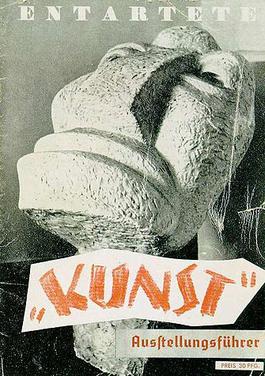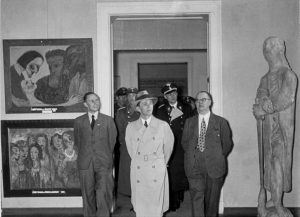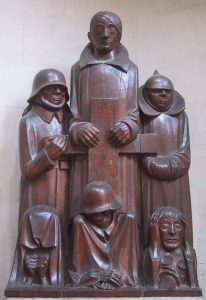“Degenerate Art” in Nazi Germany
In the early decades of the twentieth century, radical new art forms flourished in Germany. Expressionism, futurism, surrealism, cubism, fauvism, and the Dada movement, while different in their forms, shared a common mood of revolt against the established norms of both art and society and the authorities that supported those norms. Despite the inherently revolutionary nature of such work, state-owned German art museums collected and exhibited work by artists such as Otto Dix, Max Beckmann, Paul Klee, Käthe Kollwitz, and Emile Nolde.* In short, art was hot.

The catalog cover for the Degenerate Art exhibition. Notice that Kunst (Art) is in quotation marks. (Image from the Deutsches Historisches Museum
The Nazis were less open-minded on the subject. In the summer of 1937, the Nazi government in Germany staged two important art exhibits in Munich that were designed to teach the German people the difference between great art and what they termed “degenerate art”—anything that was modern, abstract, elitist** or created by a Jewish, socialist, communist, or otherwise class-conscious artist.
One exhibit was titled “Degenerate Art”, comprised of 740 works of modern art by 120 artists—part of more than 20,000 such works the Nazi removed from the state collections between 1937 and 1939. According to the exhibition catalog, the purpose of the show was to “reveal the philosophical, political, racial and moral goals and intentions behind this movement, and the driving forces of corruption which followed them. The works were displayed in a manner designed not only to mock them as “bad art” but to suggest that they were part of an international plot against the German people. ***

Nazi Propaganda Minister Joseph Goebbels visiting the Degenerate Art exhibition, which was his brainchild. Image from the German Federal Archive
The other, designated the “Great German Art Exhibition, was a “model art exhibition” of works hand-picked by Hitler for the edification of the public. It was made up of works that were traditional in style, featuring beautiful landscapes, statuesque blond nudes, and idealized Germanic soldiers. By and large, the works were perfectly competent, but they weren’t particularly exciting.
People voted with their feet. In the first two weeks after the exhibitions opened, 400,000 people visited “Degenerate Art”—a record for Germany at the time. By contrast, 129,000 visited the Great German Art Exhibition in the same period. Over the total run of the two exhibitions, which toured around Germany after their opening in Munich, the gap narrowed to three-to-one in favor of “degenerate art.”
* Nolde was a member of the Nazi party, but that didn’t protect his work from Nazi attacks. More of his paintings were exhibited in the Degenerate Art exhibit than those of any other artist, and more of his paintings were confiscated from public galleries.
**A favorite term of abuse in the insult portfolio of populist politicians.
***An idea that I find hard to wrap my mind around. How could anyone consider Ernst Barlach’s breathtaking memorial to the German soldiers who died in World War I part of a plot against the German people?





